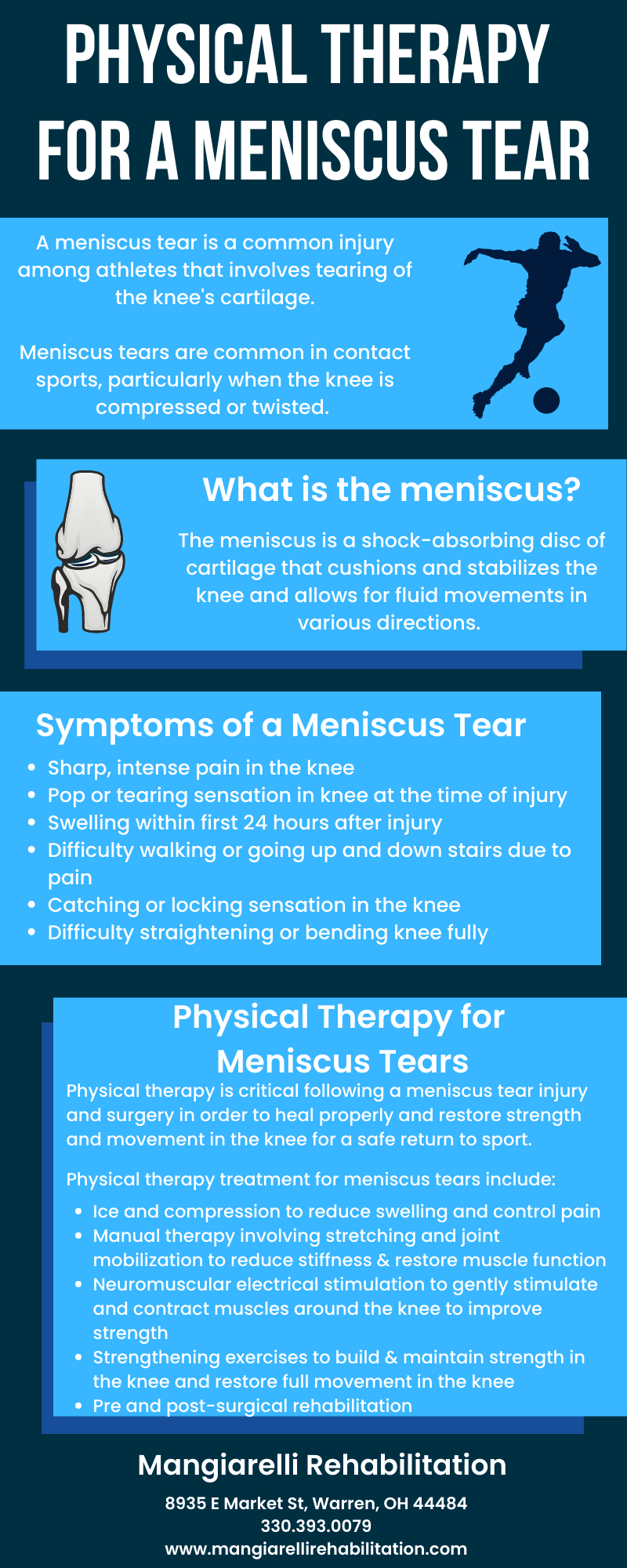Physical Therapy for a Meniscus Tear [Infographic]
The meniscus is a c-shaped disc of cartilage located within the knee that cushions and provides shock absorption between the tibia and femur. The meniscus provides a gliding surface on which the two bones can move when walking, getting up, and bending the knee. Each knee has two menisci: an inner (medial) meniscus and an outer (lateral) meniscus that work together to provide stability and distribute forces throughout the knee joint during movement.
Meniscus tears can occur in two ways: a traumatic injury such as during sports or due to degeneration of the meniscus. It is most common to tear the medial meniscus. The meniscus can tear from a forceful twist or rotation of the knee, such as a forceful pivot or sudden stop into a turning motion during sports. The meniscus can also degenerate over time due to the wear and tear of aging and osteoarthritis.
Common symptoms of a meniscus tear include sharp, intense pain in the knee; pop or tearing sensation in the knee at the time of injury; swelling within the first 24 hours after the injury; difficulty walking or going up and down stairs due to pain; catching or locking sensation in the knee; difficulty straightening or bending the knee fully; loss of knee mobility and range of motion; and decreased strength in the quadriceps and hamstrings and muscles around the knee.
Physical therapy is critical following a meniscus tear injury in order to heal properly and restore strength, mobility, and range of motion in the knee. In fact, research has shown that physical therapy can yield the same outcomes as surgery for a torn meniscus. A 2018 analysis of 321 patients with meniscus tears found that the functional improvements in patients at the 24-month mark were the same for those who received physical therapy and those that had surgery.
Research shows that for a degenerative meniscus tear, there is no added benefit to receiving surgery. Researchers compared the outcomes of two groups of people who all sustained degenerative tears of the meniscus. One group underwent a 12-week exercise program of physical therapy while the others underwent a partial meniscectomy surgery. The researchers found that there were no clinically relevant differences between the two groups in terms of pain and function after two years, meaning recovery and function were the same in the physical therapy group and the surgery group.
Research shows that you can regain normal, pain-free mobility in the knee after a meniscus injury with physical therapy and without the need for surgery. If pain and lack of function persist with physical therapy, then surgery could be beneficial, particularly for those who have experienced a traumatic, acute sports-related meniscus tear.
The goal of the physical therapist during treatment of a torn meniscus is to improve knee range of motion, strengthen the muscles around the knee, manage and decrease knee pain and swelling, and improve the functional mobility of the knee and the entire lower extremity.
Physical therapy treatment for a meniscus tear can include:
Therapeutic Strengthening Exercise: to build and maintain strength in the knee and restore full movement in the knee. The quadriceps, hamstrings, and calf muscles are specifically targeted for strengthening as weakness in these muscles can place increased pressure on the knee.
Pain Management: use of ice and compression to reduce swelling and control pain.
Manual Therapy: stretching and joint mobilizations to reduce stiffness and restore muscle function, reducing tensions in the soft tissues surrounding the knee.
Neuromuscular Electrical Stimulation: gently stimulating and contracting muscles around the knee to improve strength.
Pre- and Post-Surgical Rehabilitation: Should surgery be required, pre-surgical rehabilitation can help prepare your body for surgery. Post-surgery rehabilitation is crucial to regain full function and strength in your knee safely.
A painful meniscus tear can be debilitating and limit your function. Begin working with a physical therapist today to start your journey toward recovery and safely regain function and mobility in your knee!
